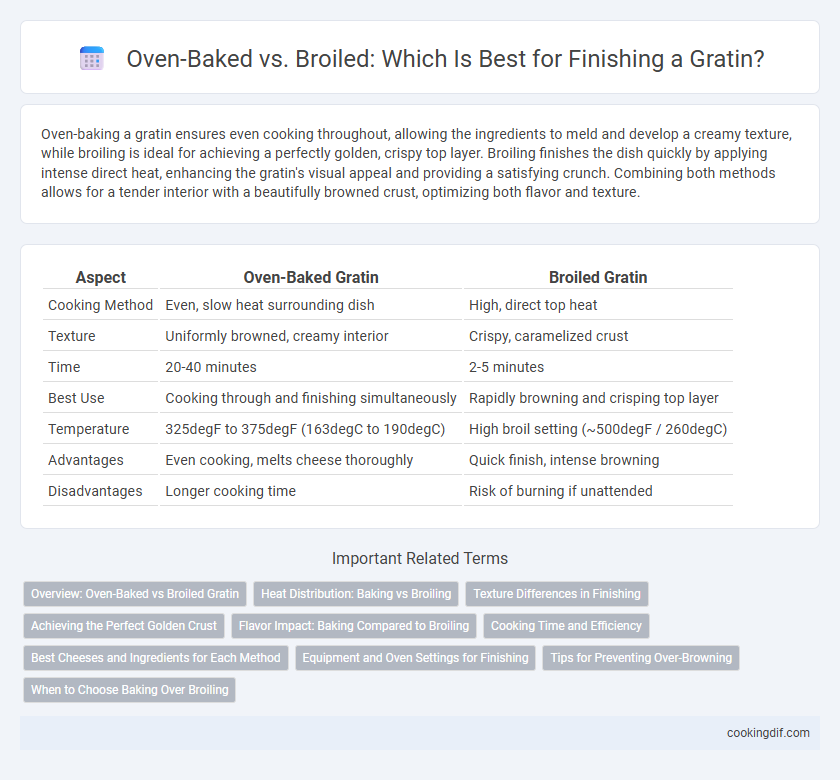Oven-baking a gratin ensures even cooking throughout, allowing the ingredients to meld and develop a creamy texture, while broiling is ideal for achieving a perfectly golden, crispy top layer. Broiling finishes the dish quickly by applying intense direct heat, enhancing the gratin's visual appeal and providing a satisfying crunch. Combining both methods allows for a tender interior with a beautifully browned crust, optimizing both flavor and texture.
Table of Comparison
| Aspect | Oven-Baked Gratin | Broiled Gratin |
|---|---|---|
| Cooking Method | Even, slow heat surrounding dish | High, direct top heat |
| Texture | Uniformly browned, creamy interior | Crispy, caramelized crust |
| Time | 20-40 minutes | 2-5 minutes |
| Best Use | Cooking through and finishing simultaneously | Rapidly browning and crisping top layer |
| Temperature | 325degF to 375degF (163degC to 190degC) | High broil setting (~500degF / 260degC) |
| Advantages | Even cooking, melts cheese thoroughly | Quick finish, intense browning |
| Disadvantages | Longer cooking time | Risk of burning if unattended |
Overview: Oven-Baked vs Broiled Gratin
Oven-baked gratin offers even cooking and a tender, golden crust through consistent, indirect heat, ideal for thorough browning and melting cheese. Broiled gratin uses intense, direct heat from above to create a crisp, browned top quickly, perfect for finishing dishes or adding texture. Choosing between oven-baking and broiling depends on the desired crust texture and cooking speed, balancing thorough baking with a crispy finish.
Heat Distribution: Baking vs Broiling
Oven-baking for finishing a gratin provides even heat distribution that cooks the dish uniformly, ensuring the creamy interior blends well with the golden crust. Broiling applies intense, direct heat from above, rapidly browning and crisping the surface but risking uneven cooking or burning if left unattended. Choosing between baking and broiling depends on the desired texture and control over heat exposure during the final stages of preparation.
Texture Differences in Finishing
Oven-baked gratin finishes with a uniformly golden, crisp crust that extends deep into the dish, enhancing the creamy interior with a satisfying crunch. Broiled gratin creates an intense, caramelized top layer that is crispier and more textured but less evenly cooked through, emphasizing a contrast between the crunchy surface and softer underneath. Choosing oven-baked yields consistent texture, while broiled offers sharper, more pronounced crispness on the topping.
Achieving the Perfect Golden Crust
Oven-baking for finishing a gratin ensures even heat distribution, creating a uniformly golden and crisp crust that seals in moisture. Broiling applies intense direct heat from above, rapidly caramelizing the cheese or breadcrumbs for a deeply browned, textured topping. Balancing time and distance from the broiler prevents burning while achieving the ideal golden crust characteristic of a classic gratin.
Flavor Impact: Baking Compared to Broiling
Oven-baking gratin develops a rich, evenly cooked texture by gently melting cheese and allowing flavors to meld deeply throughout the dish. Broiling creates a superior caramelized crust with pronounced, smoky notes due to high direct heat, enhancing the gratin's surface flavor complexity. Choosing baking over broiling results in a creamier, more uniform taste profile, while broiling emphasizes contrast with a crisp, savory finish.
Cooking Time and Efficiency
Oven-baking a gratin ensures even cooking by applying consistent heat, typically requiring 20-30 minutes to develop a golden crust and fully melt cheese. Broiling offers a faster finish, often taking just 3-5 minutes to brown the top layer efficiently but requires close monitoring to prevent burning. Combining both methods can optimize texture and cooking time, starting with baking for thorough cooking and finishing with broiling for a crisp, caramelized surface.
Best Cheeses and Ingredients for Each Method
Oven-baked gratins benefit from cheeses that melt smoothly and brown evenly, such as Gruyere, Emmental, and Fontina, which provide a creamy texture with a golden crust. Broiling emphasizes quick, intense heat for caramelization, making sharp, hard cheeses like Parmesan and Asiago ideal to create a crispy, flavorful topping. Ingredients with higher moisture content, like thinly sliced potatoes or cream-based sauces, perform better in oven-baking, while broiling suits dry toppings and cheese-only finishes for optimal texture contrast.
Equipment and Oven Settings for Finishing
Oven-baking for finishing gratin uses consistent radiant heat, typically set at 350degF to 400degF, allowing even cooking and a uniformly browned crust. Broiling utilizes intense direct heat from the top element, usually on high broil for 2 to 5 minutes, to quickly achieve a crispy, golden-brown surface without overcooking the interior. Equipment such as heavy-duty ceramic or cast iron gratin dishes withstand high temperatures, while adjustable oven racks position the dish optimally for broiling to prevent burning.
Tips for Preventing Over-Browning
To prevent over-browning when finishing a gratin with oven-baking, set the temperature between 350degF and 375degF and monitor closely during the last 10 minutes of cooking. When broiling, place the dish on a lower rack to reduce direct heat exposure and check every 1-2 minutes to avoid burning the cheese or breadcrumbs. Using a foil tent can help shield the top while allowing the gratin to brown evenly without drying out.
When to Choose Baking Over Broiling
Choose oven-baking over broiling when even, gentle heat is needed to fully cook the gratin without burning the top. Baking allows slow melting of cheese and thorough cooking of ingredients like potatoes or vegetables, resulting in a creamy, tender interior. Broiling is best reserved for creating a quick, browned crust once the gratin is mostly cooked.
Oven-baked vs Broiled for finishing Infographic

 cookingdif.com
cookingdif.com